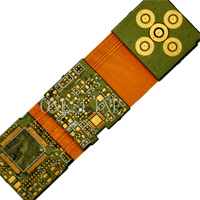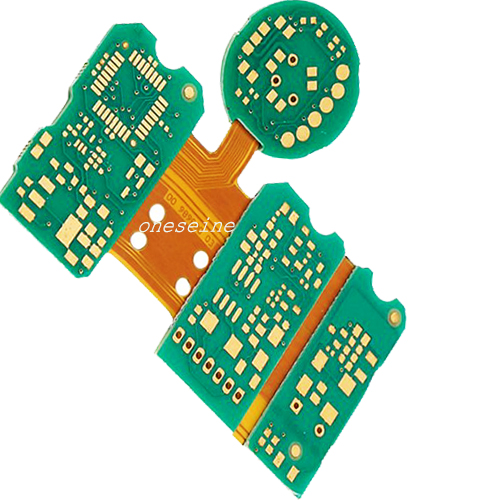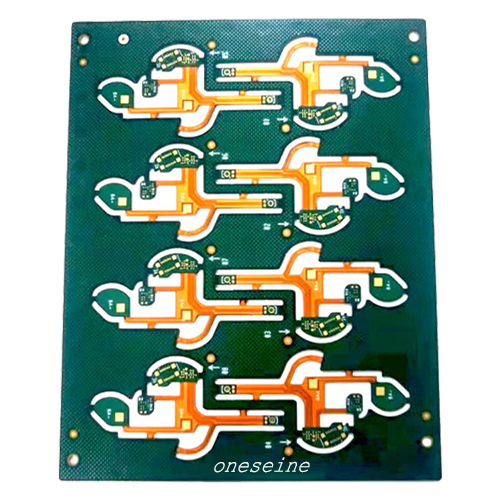Rigid-flex FPC
6 Layer Rigid Flex PCB Manufacturer FR4 Circuit Materials Fabrication
6 Layer Flex Rigid PCB Manufacturer FR4 Circuit Materials Fabrication
Product Introduction
Material: Polymide flex FR4 rigid
Number of layers: 6
Board thickness: 1.6mm rigid&0.2mm flex
Minimum aperture: 0.15mm
Minimum line width/line spacing: 0.08mm
Copper thickness: 1OZ each on the inner and outer layers
Solder resistance: green oil with white letters
Surface technology: sinking gold
Product features: 0.1mm hole to line, 0.2mm BGA pad, resin plug required for holes in the pad
Can you provide an example application where rigid-flex PCBs are commonly used?
Certainly, here's an example application where rigid-flex PCBs are commonly used:
Smartphones and Tablets
Rigid-flex PCBs are extensively used in the design of modern smartphones and tablets. These mobile devices require compact, lightweight, and flexible electronic assemblies to fit within the slim, curved, and compact form factors.
In a typical smartphone or tablet, the rigid-flex PCB serves as the central backbone, connecting various components such as:
1. Processor and memory chips: The rigid sections of the PCB provide a stable platform for mounting the main processor, RAM, and other essential integrated circuits.
2. Display and touch panel: The flexible portions of the PCB allow the display and touch panel to be seamlessly integrated, often with the ability to wrap around the edges of the device.
3. Camera module: The flexible sections of the PCB enable the camera module to be positioned in optimal locations, even in tight spaces, without compromising the overall design.
4. Battery and other components: The rigid-flex PCB can connect the battery, charging port, speakers, and other peripheral components, ensuring efficient power distribution and signal routing throughout the device.
The use of rigid-flex PCBs in smartphones and tablets allows for compact, high-density, and reliable electronic integration, contributing to the sleek and ergonomic design of these portable devices. The flexibility of the PCB also helps to absorb shock and vibrations, improving the overall durability and reliability of the electronic assembly.
This is just one example of the many applications where rigid-flex PCBs are commonly used to address the design challenges of modern, compact, and feature-rich electronic devices.
Rigid-flex PCBs (Printed Circuit Boards) are a type of electronic circuit board that combines rigid and flexible circuit board technologies into a single integrated assembly. This hybrid design offers several benefits compared to traditional rigid or flexible PCBs:
Structural Integrity: The rigid sections provide mechanical support and stability, while the flexible sections allow for bending, folding, or wrapping around objects, enabling compact and complex designs.
Interconnectivity: The flexible sections connect the rigid sections, providing electrical interconnections between different parts of the circuit board. This allows for greater design flexibility and the ability to route signals across complex 3D shapes.
Space Optimization: Rigid-flex PCBs can be designed to fit into confined spaces, as the flexible portions can be routed through tight areas or around obstacles, reducing the overall size and volume of the assembly.
Reliability: The combination of rigid and flexible materials can improve the overall reliability of the circuit board, as the rigid sections provide stability and the flexible sections can better withstand bending, flexing, and vibrations.
Manufacturability: Rigid-flex PCBs can be fabricated and assembled using automated processes, which can improve production efficiency and reduce manufacturing costs compared to traditional manual assembly methods.
Rigid-flex PCBs are commonly used in applications where space is limited, such as in portable electronics, medical devices, aerospace, and military equipment. They enable the creation of compact, lightweight, and reliable electronic systems that can be seamlessly integrated into complex, 3D-shaped products.
The design and fabrication of rigid-flex PCBs require specialized expertise and consideration of factors such as material selection, layer stackup, routing constraints, and assembly processes. Consulting with experienced PCB designers or manufacturers can help ensure the success of a rigid-flex PCB project.
Can you provide an example of how the flexible sections of a rigid-flex PCB are integrated with the rigid sections in a smartphone design?
Sure, let's take a closer look at how the flexible sections of a rigid-flex PCB are integrated with the rigid sections in a typical smartphone design:
In a smartphone, the main rigid-flex PCB is often composed of several distinct rigid sections connected by flexible sections. Here's an example of how this integration might be done:
1. Processor and Memory Section:
- The central, most rigid section of the PCB houses the main processor chip, RAM, and other critical components.
- This rigid section provides a stable and reliable platform for the high-performance computing elements of the smartphone.
2. Display and Touch Panel Integration:
- Flexible sections of the PCB extend from the processor section to the display and touch panel assembly.
- These flexible sections allow the display and touch panel to be wrapped around the edges of the smartphone, creating a seamless, edge-to-edge design.
- The flexible interconnections ensure reliable signal transmission between the processor and the display/touch panel components.
3. Camera Module Connectivity:
- Flexible portions of the PCB connect the camera module(s) to the processor section, enabling optimal camera positioning within the smartphone's slim profile.
- The flexible sections allow the camera module(s) to be placed in different locations, providing design flexibility and better camera positioning for enhanced photography and videography.
4. Peripheral Component Connections:
- Flexible sections of the PCB extend to connect other peripheral components, such as the battery, charging port, speakers, and sensors.
- This flexible interconnectivity allows these components to be placed in the most suitable locations within the smartphone's compact design.
The seamless integration of the rigid and flexible sections of the PCB enables smartphone manufacturers to create thin, lightweight, and ergonomic devices with advanced functionality and reliable performance. The flexibility of the interconnections also helps to absorb stress and vibrations, improving the overall durability of the smartphone.
This example showcases how rigid-flex PCB technology is leveraged in the design of modern smartphones to achieve the desired combination of compact form factor, high-performance electronics, and reliable functionality.
Can you explain the manufacturing process and challenges involved in producing rigid-flex PCBs for smartphone applications?
Certainly, let's dive into the manufacturing process and some of the key challenges involved in producing rigid-flex PCBs for smartphone applications:
Manufacturing Process:
1. Multilayer Lamination: The manufacturing of rigid-flex PCBs typically starts with the lamination of multiple layers of rigid and flexible materials, including copper foils, dielectric materials, and adhesives.
2. Rigid-Flex Structuring: The laminated structure is then processed to create the rigid and flexible sections, often through selective etching or mechanical cutting.
3. Interconnect Formation: Vias and plated through-holes are created to establish electrical connections between the rigid and flexible sections of the PCB.
4. Circuit Patterning: The copper layers are then patterned using photolithography and etching techniques to form the desired circuit traces and interconnections.
5. Assembly and Testing: The completed rigid-flex PCB is then populated with electronic components, followed by thorough testing and inspection to ensure reliability and functionality.
Challenges:
1. Thermal Management: Smartphones generate significant heat during operation, which can be challenging to dissipate effectively, especially in the densely packed rigid-flex PCB design. Careful thermal management is crucial to ensure reliable operation and prevent overheating.
2. Flexibility and Durability: The flexible sections of the PCB must be able to withstand repeated bending, flexing, and torsion without compromising the integrity of the electrical connections. Achieving the right balance between flexibility and durability is essential.
3. Dimensional Stability: Maintaining dimensional stability and alignment between the rigid and flexible sections during the manufacturing process is critical to ensure proper fit and interconnectivity within the overall smartphone design.
4. Material Compatibility: The choice and compatibility of the materials used for the rigid and flexible sections, as well as the adhesives, are crucial to minimize issues like delamination, warping, or mismatch in thermal expansion coefficients.
5. Miniaturization and High Density: Smartphones demand increasingly compact and high-density PCB designs, which can be challenging to achieve with rigid-flex technology, requiring advanced fabrication techniques and tooling.
6. Testing and Inspection: Comprehensive testing and inspection methods are necessary to identify and address any manufacturing defects or reliability issues in the rigid-flex PCB before final assembly.
Overcoming these challenges requires specialized expertise, advanced manufacturing capabilities, and close collaboration between PCB designers, materials scientists, and production engineers to ensure the successful fabrication of reliable and high-performing rigid-flex PCBs for smartphone applications.
News
Contact Us
Contact: Flexible PCB
Phone: 0086 18682010757
E-mail: kico@oneseine.com
Add: B area,101 Buliding,No12,Fushan 2th Road,Doumen,Zhuhai,China



